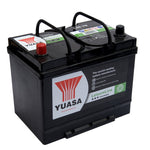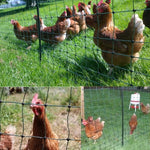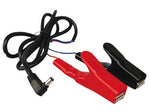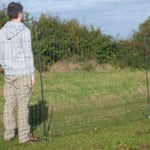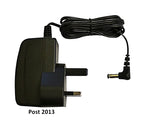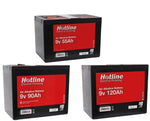You have no items in your shopping cart.
Electric Fencing for Sheep
 |
Using Electricity to Control SheepElectricity is a highly effective means of controlling sheep |
Electric Sheep Fencing is a tried and tested, effective Fence.
Electric fencing is a cost-effective and good way to contain sheep. Although sheep can be relatively difficult to contain with electric fencing due to their thick wool coats. Wool does not conduct electricity so you will require more power than when fencing shorthaired animals. An added problem is keeping predators out such as foxes preying on Lambs in the springtime.
Electric fencing can be used to contain them in whole fields or parts of fields for strip grazing. Sheep are always looking for a route to escape seeing the grass is always greener on the other side. It can be very costly investing labour and time into driving them back to the fields and repairing conventional fencing that has been damaged and isn't that effective
Electric Sheep Netting
Electric netting combines traits of net-wire and electric fencing, providing a formidable mental and physical barrier for sheep in a portable format suitable for temporary or semi-permanent sheep fencing of pastures. It is constructed of polywires and plastic twines. It is usually supplied in fixed lengths of 50 or 25 meters with support posts already installed.
Netting is lightweight and easy to install. Compared to other temporary fences, electric netting provides greater protection from predators. because lambs are erratic and a target for predators, consider the use of electric netting, particularly for lambing pens, as it makes containing lambs and exclusion of foxes much easier.
Perimeter Fencing
Perimeter fencing is usually installed around the boundary of the property (or grazing area) and is the first line of defence against predators. It is intended to last for a long period of time and should be constructed of high quality materials. Suitable perimeter fences for sheep are multi-strand, high-tensile, electric fences and woven wire fences with electric offset wires at the top and bottom of the fence.
High-tensile electric fences last for a long time, are relatively easy to install, and cost less than other types of fencing. Whereas cattle can often be controlled with 1 or 2 strands of electric wire, sheep require multiple strands, not just to keep them in, but to keep predators out.
Five, six or seven strands of 12 ½ gauge high-tensile wire is common for sheep fences. The bottom wires of the fence are more closely spaced than the top wires. Wire spacing's of approximately 6, 5, 5, 8 and 10 inches are typical. In areas where there is relatively even rainfall and some green vegetation most of the year, it is recommended that all wires be hot.
High-tensile fences are made with smooth wire pulled relatively taught - there is no need to be able to play a guitar solo on the wires. They require strong corners and end braces to achieve a reasonable tension. The wire is held on fence posts with insulators. These insulators allow freedom for the wire to move during tensioning, temperature changes, or livestock pressure.
The Energiser
A 4,000 volt energiser is usually sufficient for sheep when the head comes into contact with the fence. Due to the thick wool the body of the sheep would not feel this voltage so a range of HotShock energisers that run at higher voltages than standard energisers will give you far better control of sheep. These have a greater ability to penetrate the wool insulation of the sheeps body.
It is important to note that an electric fence much more of a psychological barrier rather than a physical one. Sheep and lambs must be trained to respect electric fence. Once trained, they will usually respect the fence even if it is off for any reason.
Temporary Interior fencing
Interior fences (or cross fences) are used to subdivide fields into smaller areas for effective grazing management. Interior fences may be constructed from permanent, semi-permanent, or temporary fencing materials.
While an interior fence does not need to deter predators, it may need to be good enough to keep weaned lambs away from their dams and/or rams away from ewes. Temporary fencing can be used to enclosed areas for temporary grazing (e.g. a wheat field). Different materials can be used to construct temporary electric fences: Stranded galvinised wire, polywire, polytape, and electric netting (or net fence).
Stranded Wire
Light weight, galvanised stranded wire is most suitable for semi-permanent fences that will not be moved constantly. Two or three wires is usually sufficient to control sheep and lambs.
Polywire and Polytape
The most common materials used for temporary fencing are polywire, polyrope and polytape. All are combinations of metal and plastic filaments. Polywire has the appearance of heavy cord or plastic baler twine. It comes in several colors or combinations of colors. Several grades are available depending upon the number of filaments and gauge of the conductor. Most polywire sold is either 6 or 9 strand.
Polytape similarly comes in several options and should be purchased on the basis of the number of filaments and the quality of the plastic weave. Compared to polywire, tape has the advantage of greater visibility, which leads to quicker animal recognition and training to the fence. Polywire is less expensive and lasts longer. Poly products come in reels with various capacities. If you plan to move a fence, reels are an absolute necessity for polywire and polytape.
Step-in posts
Plastic step-in posts are the most common line posts used with poly products. They are the easiest to use, especially if the fence will be moved frequently. The pre-molded loops provide plenty of flexibility for wire spacings. The metal re-bar pig posts are cheaper and last longer than plastic or fiberglass posts. They require insulators to hold the wires and can be difficult to get in the ground when the soil is hard.

